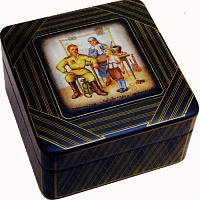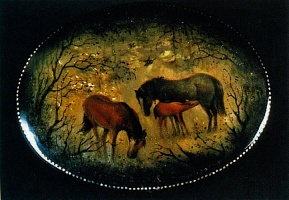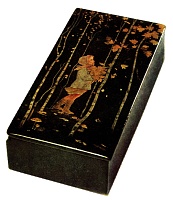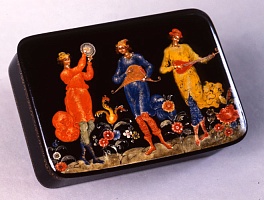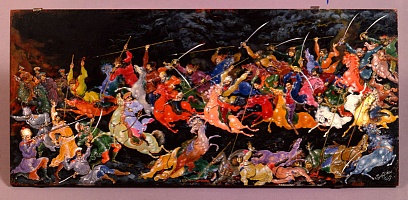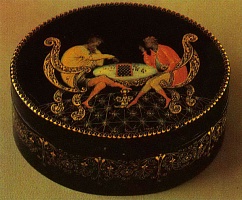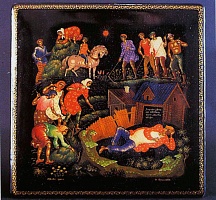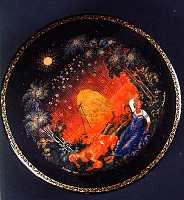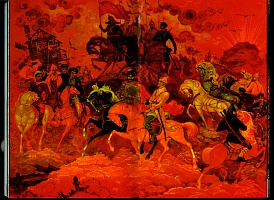Painting on Papier-Mache (Fedoskino, Palekh, Mstera, Kholui)
The Museum preserves a varied collection of miniature lacquer painting on papier-mache. This kind of applied and decorative art appeared in the village of Fedoskino, Moscow region, at the turn of the 19th
century.
Its history began at the end of the 18th century, when a merchant P.I. Korobov organized an enterprise producing lacquered articles of papier-mache in the village of Danilkovo not far from Fedoskino. Soon the handicraft spread throughout the district.
The Museum collection presents works made at the factory of Lukutin (P.I. Korobov’s successors). The earliest works date back to the mid-19th century. The products of these workshops are stylistically similar: boxes, caskets, cigarette-cases, purses, snuff-boxes of papier-mache, decorated with realistically treated miniatures, depicting popular scenes. The traditional “troikas”, “tea-drinking parties”, scenes of folk life are usually free reproductions of paintings and drawings of Russian artists. Since the second half of the 20th century, there prevailed poetic and romantic themes in Fedoskino works. .
In Fedoskino miniatures there developed a special manner of painting. Scenes are painted in oil against a deep black background and covered with vanish. The characteristic features are bright local colors, laconic drawing, distinct compositions, usually including a few figures. In Fedoskino works we can see a variety of subjects. Alongside with traditional tea parties and round dances, heroic themes of the Revolution, the civic and Great Patriotic wars, space flights, are often depicted. .
Many landscapes are deeply poetical. Among them “Autumn” by G.I. Larishchev. Decorative and ornamental paintings, known in the 19th century, are widely used in contemporary works, as well. The diverse artistic techniques demonstrate the great skill of the Fedoskino artists.
Other centers of lacquer miniature painting - Palekh, Mstera and Kholui - appeared after the Revolution. The idea to produce lacquer articles of papier-mache was borrowed from the Fedoskino craftsmen. The largest and the most significant among the new centers is the village of Palekh in Ivanovo region. There flourished icon-painting for several centuries in the past. The best features of this heritage were revised and introduced to the new kind of applied and decorative art, initiated by the Palekh artists. The Palekh artistic manner was affected by a superb technique of drawing and magnificent colors, worked out over the centuries.
The particular methods of a flat space treatment were preserved and, at the same time, Palekh lacquer miniatures present an original kind of tempera painting. The Museum collection of Palekh miniature painting is unique. It represents different periods, but it is especially rich in the works produced by the artists of the elder generation: I.I. Zubkov, I.V. Markichev, I.M. Bakanov, A.I. Vatagin, N.M. Zinoviev. The most remarkable are works of I.I. Golikov, who initiated the classical Palekh style.
I.I. Golikov’s plate “Battle”, praising the stormy and rebellious revolutionary epoch, is characteristic. This most dynamic composition conveys an insuppressible movement and intensity of severe battle. The galloping green, lilac, pink, blue, red horses are depicted in the most complicated views. The life of the Soviet village is originally reflected in I.I. Golikov works. The figures of his characters in the snuffbox “Tree Musicians” are elongated, the flowing fold of their clothes are modeled with highlights, like in the icons.
The village of Mstera in Vladimir region is another center of miniature painting, famous for its icon-painters in the past. For all similarity with other centers, Mstera lacquer miniatures are of a distinct character. In Mstera paintings the black background is ignored. The beauty of the surrounding world is rendered in a poetic conventional manner. The decorative nature appear in bright painting without contrasting colors, with a favorite combination of warm tones: golden, red, white and clear green and blue tints. The dynamic rhythm of drawing is achieved by tightly curled waves, thick clouds, indented coastlines, red and green hills, expressive figures of running animals. The human figures look somewhat stumpy..
The village of Kholui in Ivanovo region is the youngest center of lacquer miniature painting, which was also based on icon-painting. Here, like in Mstera, the black background is practically absent and the surrounding world is realistically treated. Heroic episodes from Russian history and modern scenes are rendered in complicated many-figured compositions. The color scheme is composed of characteristic contrasting combinations of warm and cold tones. In some works the color symbolism can be traced. The figures and objects are special. The elongated human figures in streaming clothes, flapping flags, wild manes of galloping horses are contoured with flexible lines. Such are the works of the handicraft founders – S.A. Mokin, V.D. Puzanov, K.V. Kosterin, and their successors: B.V. Tikhonravov, I.B. Baburin, N.N. Denisov and others.
Its history began at the end of the 18th century, when a merchant P.I. Korobov organized an enterprise producing lacquered articles of papier-mache in the village of Danilkovo not far from Fedoskino. Soon the handicraft spread throughout the district.
The Museum collection presents works made at the factory of Lukutin (P.I. Korobov’s successors). The earliest works date back to the mid-19th century. The products of these workshops are stylistically similar: boxes, caskets, cigarette-cases, purses, snuff-boxes of papier-mache, decorated with realistically treated miniatures, depicting popular scenes. The traditional “troikas”, “tea-drinking parties”, scenes of folk life are usually free reproductions of paintings and drawings of Russian artists. Since the second half of the 20th century, there prevailed poetic and romantic themes in Fedoskino works. .
In Fedoskino miniatures there developed a special manner of painting. Scenes are painted in oil against a deep black background and covered with vanish. The characteristic features are bright local colors, laconic drawing, distinct compositions, usually including a few figures. In Fedoskino works we can see a variety of subjects. Alongside with traditional tea parties and round dances, heroic themes of the Revolution, the civic and Great Patriotic wars, space flights, are often depicted. .
Many landscapes are deeply poetical. Among them “Autumn” by G.I. Larishchev. Decorative and ornamental paintings, known in the 19th century, are widely used in contemporary works, as well. The diverse artistic techniques demonstrate the great skill of the Fedoskino artists.
Other centers of lacquer miniature painting - Palekh, Mstera and Kholui - appeared after the Revolution. The idea to produce lacquer articles of papier-mache was borrowed from the Fedoskino craftsmen. The largest and the most significant among the new centers is the village of Palekh in Ivanovo region. There flourished icon-painting for several centuries in the past. The best features of this heritage were revised and introduced to the new kind of applied and decorative art, initiated by the Palekh artists. The Palekh artistic manner was affected by a superb technique of drawing and magnificent colors, worked out over the centuries.
The particular methods of a flat space treatment were preserved and, at the same time, Palekh lacquer miniatures present an original kind of tempera painting. The Museum collection of Palekh miniature painting is unique. It represents different periods, but it is especially rich in the works produced by the artists of the elder generation: I.I. Zubkov, I.V. Markichev, I.M. Bakanov, A.I. Vatagin, N.M. Zinoviev. The most remarkable are works of I.I. Golikov, who initiated the classical Palekh style.
I.I. Golikov’s plate “Battle”, praising the stormy and rebellious revolutionary epoch, is characteristic. This most dynamic composition conveys an insuppressible movement and intensity of severe battle. The galloping green, lilac, pink, blue, red horses are depicted in the most complicated views. The life of the Soviet village is originally reflected in I.I. Golikov works. The figures of his characters in the snuffbox “Tree Musicians” are elongated, the flowing fold of their clothes are modeled with highlights, like in the icons.
The Palekh artists are brightly individual. They create original compositions on various themes. The scenes from Russian fairy tales are depicted with wonderful fantasy. In these works, alongside with fabulous images, realistic characters are poetically portrayed. The powder-box “Noon” is a classical example of miniature painting. The great ornamental skill is traced in the thing gold patterns decorating Palekh caskets. The Palekh artists are also known as outstanding decorators, book illustrators and masters of colorful monumental paintings
The village of Mstera in Vladimir region is another center of miniature painting, famous for its icon-painters in the past. For all similarity with other centers, Mstera lacquer miniatures are of a distinct character. In Mstera paintings the black background is ignored. The beauty of the surrounding world is rendered in a poetic conventional manner. The decorative nature appear in bright painting without contrasting colors, with a favorite combination of warm tones: golden, red, white and clear green and blue tints. The dynamic rhythm of drawing is achieved by tightly curled waves, thick clouds, indented coastlines, red and green hills, expressive figures of running animals. The human figures look somewhat stumpy..
The village of Kholui in Ivanovo region is the youngest center of lacquer miniature painting, which was also based on icon-painting. Here, like in Mstera, the black background is practically absent and the surrounding world is realistically treated. Heroic episodes from Russian history and modern scenes are rendered in complicated many-figured compositions. The color scheme is composed of characteristic contrasting combinations of warm and cold tones. In some works the color symbolism can be traced. The figures and objects are special. The elongated human figures in streaming clothes, flapping flags, wild manes of galloping horses are contoured with flexible lines. Such are the works of the handicraft founders – S.A. Mokin, V.D. Puzanov, K.V. Kosterin, and their successors: B.V. Tikhonravov, I.B. Baburin, N.N. Denisov and others.










